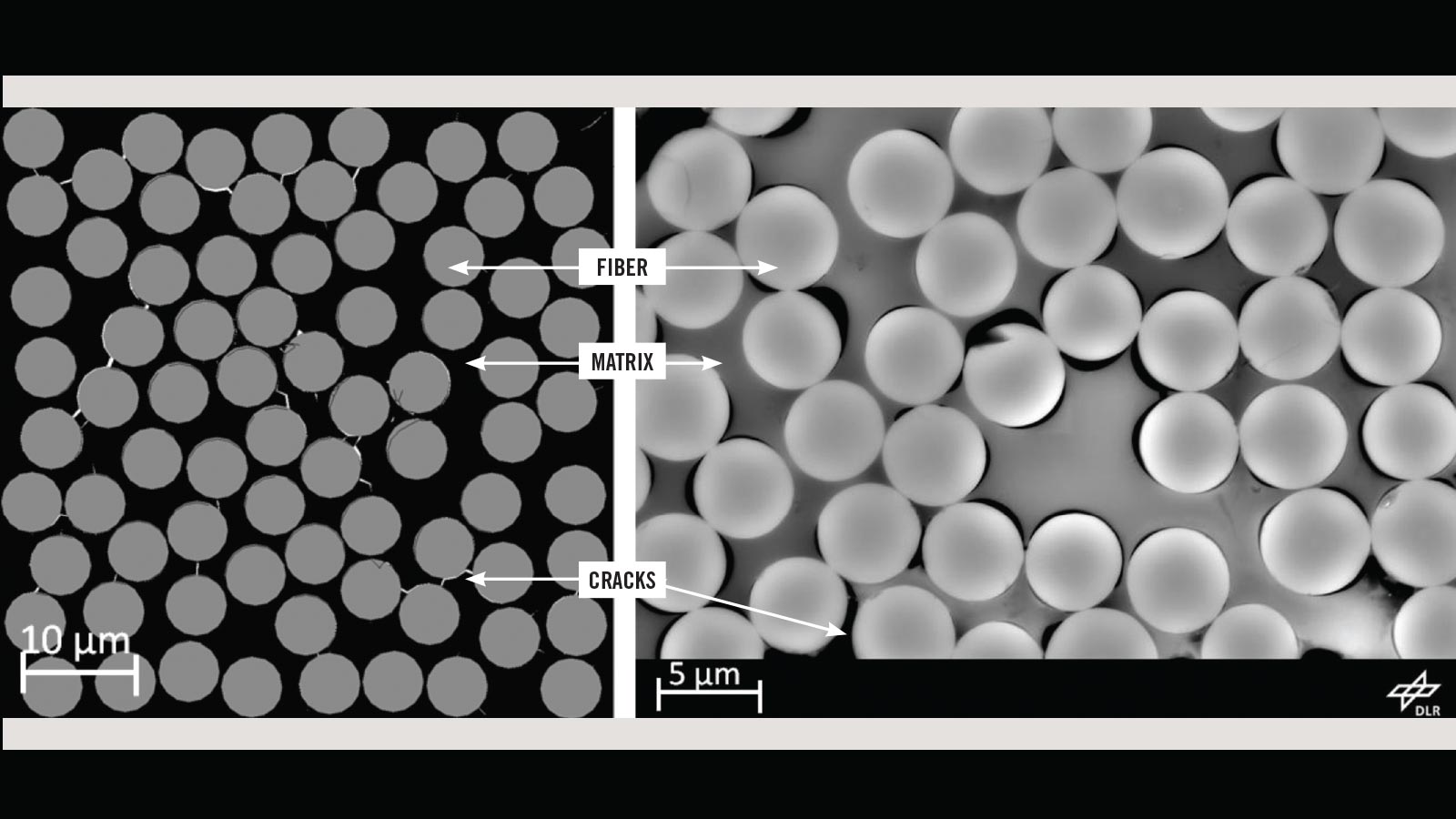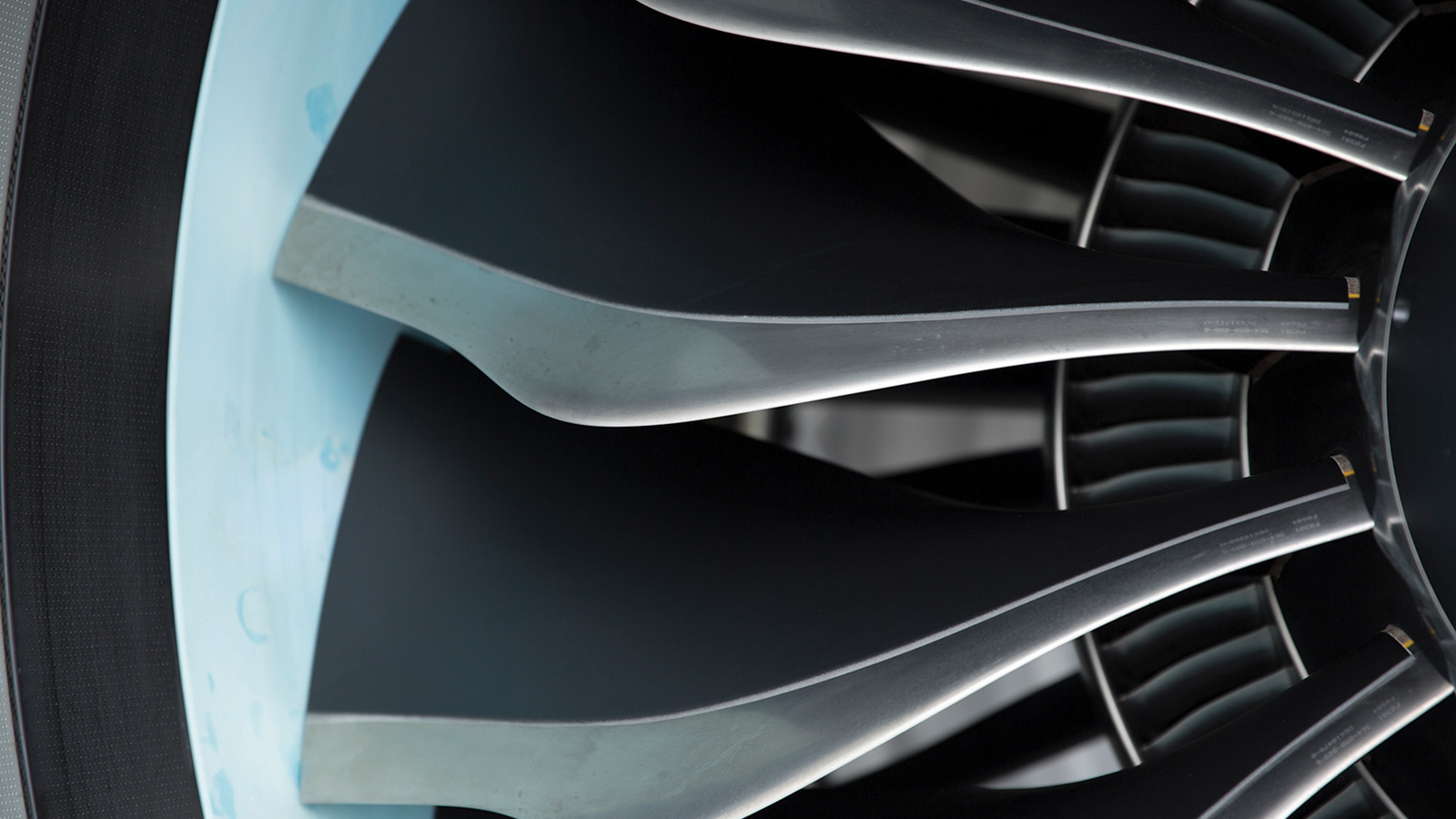Stay Up to Date
Submit your email address to receive the latest industry and Aerospace America news.
Conjuring a new version of a composite and testing it can be expensive and time consuming. By testing for strength virtually, some materials scientists are beginning to rule out certain blends without making samples, and engineers are learning to rapidly identify the best candidates for specific applications. Keith Button tells the story of this software.
Want to know how strong something is? Break it.
That’s how materials scientists have traditionally operated: Pull it, flex it, compress it, repeatedly bend it back and forth, twist it, slam it with a hammer — until it breaks. Such tests are crucial for a new material, because aerospace engineers need data before deciding whether that material might be suitable for airplane wings, engine parts and other structures.
Some scientists and engineers are beginning to anticipate the strength of new carbon composites without making samples and testing them. The calculation challenges of this virtual testing are enormous, and engineers must still test a material before trusting it in aircraft structures or jet and rocket engines. But trial and error is reduced, and engineers can quickly identify the best candidates for a particular application.
Those are the challenges that computational mechanics engineer Flavio Souza took on when he founded MultiMechanics, a Nebraska software company purchased by Siemens last November and folded into the Germany-based technology giant. Souza now works with his staff in Orlando, Florida, under the Siemens Digital Industries Software unit.
This is the story of Souza’s company and its virtual testing software, called MultiMech. Today, customers including DLR, the German Aerospace Center, rely on Souza’s software to predict the mechanical strength of new materials, especially carbon fiber composites.
Early work
Our story begins in 2006, when Souza moved to the U.S. from Brazil to work on his engineering mechanics doctoral degree at the University of Nebraska. Souza sensed the excitement over new materials, especially composites, but he also saw a problem.
“There were materials being created and nobody knew how to properly simulate them,” he recalls. Creating physical samples and testing them in the lab was a poor option because of the expense and time. “I set out to try to develop something that would be efficient,” he says.
So in 2010, after earning his doctorate, he and his business partner, Leandro Castro, formed MultiMechanics to develop software that would accurately model the strength of materials.
At the time, most mathematical models of new materials were adapted from models of existing materials, such as metal alloys, whose characteristics are vastly different from those of carbon fiber composites. Carbon fibers, some of which are 10 times thinner than a human hair, introduced a level of complexity that even large computers had difficulty modeling. With potentially billions of fibers in a carbon fiber composite airplane wing, each linking at different points and different angles, “it’s impossible to match that kind of geometry; account for every single fiber,” Souza says. Computer simulations of new materials that were based on models of existing materials could take several days to complete, and their accuracy was suspect. Some relied on simplified models or assumptions that sped up the simulations but sacrificed accuracy.
Examining microstructures
Souza believed that the key to modeling new materials lay in their microstructure, not in applying physical loads to a material to test its strength. “The way you load the material does not define the property; the property is already there,” he explains. “It’s just a matter of finding a way to try to extract that information from the material’s microstructure without having to apply a load. I pushed through that belief for three years, two and a half years.”
Souza’s starting point at MultiMechanics was the mathematical formula he developed in graduate school to define how strong a material was at a microscopic point that might measure just 2 microns by 2 microns. The first iteration of his software was based on this microstructure mathematical formula, and it modeled how the material would crack at the microscopic level. But Souza faced a scaling-up problem that would take years to resolve. To predict how strong a material was at the size of an engine part or airplane wing, his software needed to calculate the microstructure model for the millions of points contained in that larger object. To minimize computing time and memory required to make those calculations, he needed to minimize the number of microstructure models that the software had to analyze.
His solution: Reuse the calculation results from microstructure models that had similar virtual cracks. While none of the microstructures would have cracks with exactly the same direction and length, those with similar cracks could be grouped together. By applying this form of multiscale finite element modeling, the software saved time and computer memory by not having to run new calculations for every individual microstructure. Also, anyone running the software could dial in the level of accuracy versus the speed of the calculations. The more similar the microstructures had to be for the software to reuse the calculations, the more accurate the software’s results would be. But increased accuracy would come at the cost of computing speed. In 2017, Souza wrapped the scaling-up concept into the software. His company’s main customer, Solvay, a materials and specialty chemicals company based in Brussels, became an investor.
Then Souza and his 10 employees spent another two years refining the software by making the coding more efficient and improving how it managed computer memory during its calculations.
Modeling composites for DLR
DLR became a customer in 2018, when it began virtually testing new carbon fiber ceramic composites with the MultiMech software, specifically composites made for high-temperature aerospace applications, such as rocket engine surfaces and jet engine turbine blades, where temperatures can exceed 2,000 degrees Celsius.
The software helps DLR narrow the field when it is considering various combinations of carbon fibers and resins to create a new composite, says Neraj Jain, head of simulation and engineering for the ceramics group at DLR in Stuttgart, Germany. Typically the resin is a liquid or paste, and the carbon fiber is a continuous thread or woven like cloth. The fiber is dipped in the resin and draped or wound around a form, or pressed in a mold with the resin, and then fired in a furnace to create the hardened ceramic composite, and then milled into its final shape. Each potential composite has at least 10 potential candidates of carbon fiber, each with its own diameter and elastic properties, and each fiber can be formed into multiple types of weaves or threads. Then there are 10 to 15 types of resins with known properties, or 100 to 150 types if all possible resins are included.
Instead of physically making a composite ceramic from every possible fiber-resin combination being considered, the software helps the DLR engineers pick the best few, Jain says. “Then I can really go into the research process where I can specifically manufacture the material and test it, and then I can validate the predictions which I made with my preliminary analysis: Does it match or not?” Before they started running Souza’s software, the DLR engineers would eliminate new composite candidates based on the ceramic group’s experience with the materials over about 30 years, but they may have been missing out on new and unfamiliar carbon fiber materials. The software helped them broaden their range.
The software produces a mathematical depiction of how cracks would form in the microstructure, and those virtual cracks tell the DLR engineers about the strength and flexibility of the composite material. If a crack is smaller and it zigzags wherever it meets with a fiber, then it signifies that the material will be ductile, won’t be brittle, and won’t break readily under strain. If a crack is longer and cuts more of a straight line, it signifies that the material is more likely to break apart.
DLR engineers have given MultiMechanics feedback on the software and their thoughts about new capabilities they would like to see added to it, such as modeling microstructures at multiple temperatures and over time after repeated exposure to extreme temperatures, Jain says.
For the future development of the software, Souza and his team are examining how the microstructure modeling can be tweaked to tell materials scientists about other properties besides strength, such as heat resistance, acoustic characteristics, thermal characteristics and characteristics of fluids, such as viscosity. They’ve also applied the software to new types of structural foams and metal alloys.
“You can tie basically everything back to the microstructure information,” Souza says. “Right now we’re more focused on structural, mechanical characteristics. But the technology can absolutely be extrapolated to other physics, like thermal diffusion or other things.”
“The way you load the material does not define the property; the property is already there. It’s just a matter of finding a way to try to extract that information from the material’s microstructure without having to apply a load. I pushed through that belief for three years, two and a half years.”
Computational mechanics engineer Flavio Souza
About Keith Button
Keith has written for C4ISR Journal and Hedge Fund Alert, where he broke news of the 2007 Bear Stearns hedge fund blowup that kicked off the global credit crisis. He is based in New York.
Related Posts
Stay Up to Date
Submit your email address to receive the latest industry and Aerospace America news.






